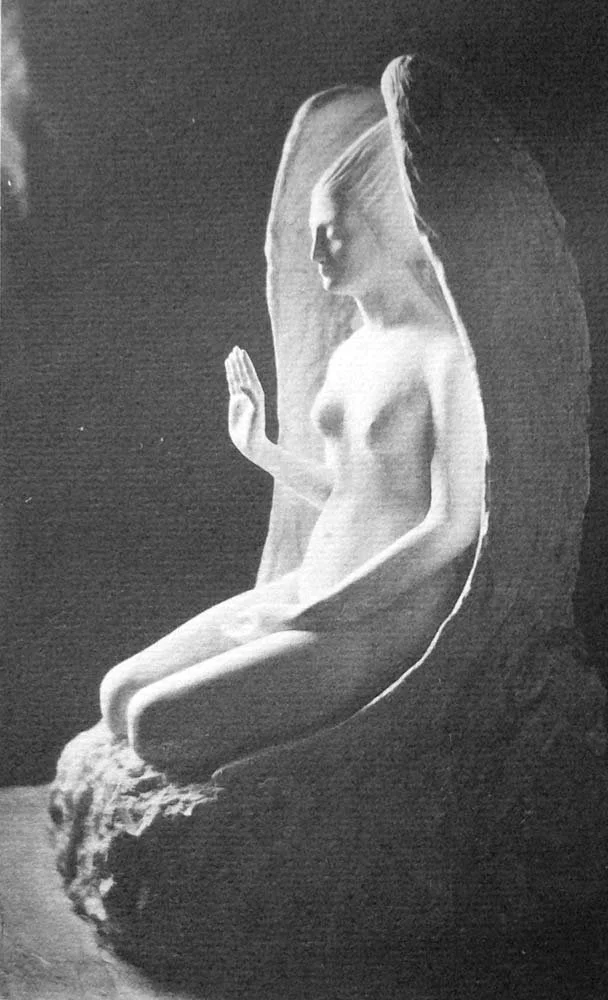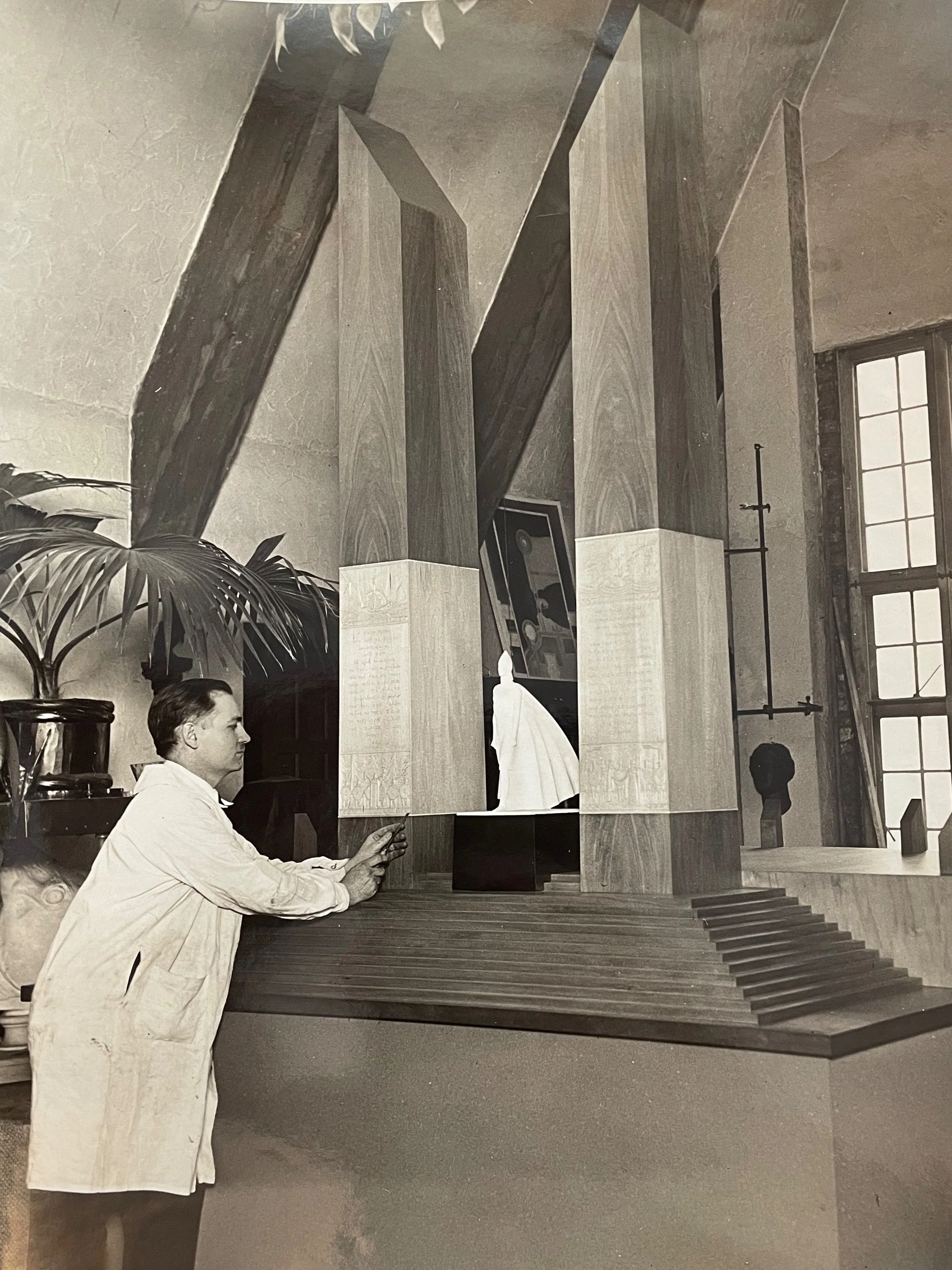About Oskar J. W. Hansen
Oskar J. W. Hansen (1892–1971), the sculptor of Hoover Dam and the Yorktown Victory Monument, is one of the most complex and fascinating public figures of the 20th century.
His mysterious story, full of outlandish claims, has never before been told and we’re actively working on researching his life and art with plans to publish a comprehensive book, coming soon.
1892: Oskar J. W. Hansen Born in Norway
Oskar J. W. Hansen is born in the remote Arctic Circle fishing village of Langenes, Norway to an unwed mother, Josefine.
Oskar's paternity is the first major mystery in his story, with claims his father is secretly Oscar II, the King of Norway and Sweden.
1895–1904: Oskar Raised by Foster Family
Oskar's mother gives up custody of him and he is raised by a foster family on Klo farm.
Oskar claims that as a young boy, he and a friend steal a sailboat in the middle of the night and sail out to a remote ocean island where they claim to discover hundreds of Viking burial mounds full of artifacts, then almost die in an orca whale attack on their sail home.
1905–1910: Oskar Sent Out to Sea as a Cabin Boy
Around 13 years old, Oskar is sent away to sea as a cabin boy on a series of merchant ships. He first learns sculpture aboard the ship.
Over the course of a few years he claims to sail around the world multiple times, fight with the French Foreign Legion in Morocco, tour Italy, Greece, and Egypt, learn sculpture, and study with Auguste Rodin in France, all before jumping ship and swimming to the United States.
1910–1914: Oskar Swims to U.S. and Joins the Army
Oskar claims to swim ashore in North Carolina at age 18, travel to New York and soon after join the US Army.
He claims to fight along side Pancho Villa during the Mexican Revolution, get captured and sent to a military prison, then escape prison and sneak through the Mexican jungle back to safety in Texas.
1914–1925: Oskar Attempts to Settle Down in Illinois
After leaving the Army in Texas, Oskar moves to Illinois where he enrolls at Northwestern University with plans to become a minister.
Soon after, Oskar marries his first wife, Eva Brubaker and becomes a citizen with the help of President Woodrow Wilson. Oskar rejoins the Army as an infantry officer. He tells stories of tremendous heroism and many promotions while serving in World War I.
Oskar begins work as an interior designer and dabbles in sculpture. Oskar and Eva have three children, Homer, Philip, and Beatrice.
1925–1928: Oskar Destroys Family to Become Artist
In a front-page news courtroom scandal in Chicago, Oskar is caught in a relationship with one of his art models, leading to a divorce from Eva. This will be the first of many infidelities.
Eva successfully raises their three children on her own through the Great Depression.
Oskar moves to Chicago, begins to find success as a sculptor, writes his first essays on mysticism, and publishes a short fiction book Chien-Mi-Lo.
1928–1930: Oskar’s Sculpture Career Grows
Oskar befriends Nobel Prize laureate, Albert Michelson, the discoverer of the speed of light, who serves as Oskar's best man in his second marriage to Mary Beatty.
Mary gives birth to Oskar's fourth child, Oskar J. W. Hansen, Jr. who goes by "Kar."
Oskar receives a large number of prominent sculpture commissions, including his Wings statue the lobby of Rand Tower in Minneapolis, the Hinsdale Victory Monument in Illinois, busts for the Editorial Hall of Fame, and more.
1931–1935: Leif Erikson Memorial in Chicago
Oskar is selected to design a 90-ft-tall memorial to Leif Erikson to stand in Grant Park in downtown Chicago, making it among the largest monument statues in the U.S..
President Herbert Hoover sends Oskar to Norway to represent the United States at the wedding of the Crown Prince of Norway and to send an invitation for the Norwegian royal family to visit America and the Erikson project.
However, Depression-related funding cuts cancel the Leif Erikson Memorial plans and it is never built.
1936–1941: The Sculptures at Hoover Dam
Oskar is selected as the sculptor for Hoover Dam, one of the largest engineering and construction projects in human history and a major priority for the FDR Administration.
Oskar designs a variety of sculptures for the site, including bas reliefs for the dam's two elevator towers, memorial plaques to Dr. Mead and the construction workers who died during the construction of the dam, and most prominently, his "Winged Figures of the Republic" bronze statues and the terrazzo 26,000-year "Star Map" they sit on.
While living in Nevada during construction, Oskar begins collecting rare gems. Among other pieces, he obtains a large piece of turquoise which he carves into a wild stallion. The turquoise stallion is put on permanent display in the entrance to the gem room of the Smithsonian Natural History Museum.
1942–1949: Oskar Buys Jefferson’s Pantops Mountain
Oskar and Mary use the proceeds from Oskar's Hoover Dam work to buy the 350-acre Pantops Mountain outside of Charlottesville, VA, a property previously owned by Thomas Jefferson.
Oskar begins elaborate plans, that would take the rest of his life, to build a home and sculpture studio on the mountain.
Oskar and Mary have a second son, Alex, who grows up at Pantops.
Starting in 1948, as a way to make more steady cashflow, Oskar begins designing a series of dozens of brass leaf trays for Virginia Metalcrafters. These trays will be among VM's best selling products for decades and will be among Oskar's only commercial endeavors.
1950–1957: The Yorktown Victory Monument
Oskar is commissioned by the U.S. Congress to sculpt a replacement statue for the Yorktown Victory Monument after the original is destroyed by lightning.
The project goes significantly over time and over budget, ends up involving lawsuits, newspaper allegations, tax scandals, and is eventually settled by an act of Congress specifically for the purposes of resolving Oskar's personal financial situation.
Oskar's statue of Liberty is eventually installed and dedicated, with tremendous fanfare in an international celebration that includes Oskar's new friends, the French Ambassador and the Marquis de La Fayette.
1958–1963: Oskar’s Second Holy Grail
After 30 years of turbulent marriage—due to Oskar’s temper and infidelity—Mary and Oskar divorce and Alex moves with his mother to California.
Oskar begins his final major art project. After building a collection of the world's largest precious gem stones and gold, Oskar begins carving them with religious symbols with plans to create a second Holy Grail chalice as his priceless gift to the world.
Oskar marries his final wife, Hope Clark, who is 30 years younger than him, and serves as something of a caretaker for him in his final decade.
Between the financial stress of the Yorktown project and Oskar's over-investment in gemstones, Oskar runs out of money and is forced to declare bankruptcy.
1964–1971: Oskar’s Decline
A huge collection of political leaders, including Lyndon Johnson, Hubert Humphrey, and Gerald Ford, work to get Oskar a Presidential "Medal for Merit" in recognition for his significant public monuments, and in particular as the Sculptor of Liberty. Despite their efforts over many years—and because of a technicality—Oskar never receives the award.
Late in his life, Oskar self-publishes Beyond the Cherubim a dense collection of autobiographical essays, including some fascinating and mysterious scientific theories about advanced military weapons.
In Oskar's last year, the US Navy hosts a gala reception in his honor as thanks for his Yorktown Liberty head donation.
After years of declining health, Oskar dies in August 1971.
1972–2020: Destruction and Disappearance
Because of Oskar's financial difficulties and bankruptcy, immediately after he dies, his widow Hope is evicted from Pantops and scrambles to find buyers for his art. She buries Oskar in an unmarked grave.
After being abandoned, Pantops is ransacked and the buildings are damaged beyond repair. The grounds are converted into the sports club of a luxury housing development.
In the years following Oskar's death, his incredible life story and—with the exception of his major monuments—his collection of artwork rapidly disappears.
His descendants are largely estranged.
50 years after his death, there are no records of any art galleries or auctions with Oskar art and his Wikipedia page is only two sentences long. His story is almost completely lost.
2020–present: Research and Restoration Begin
Since starting our work in 2020, we have located many of Oskar's lost sculptures, uncovered a huge portion of his remarkable life, reunited multiple lost descendants, and begun to tell his story again.
In 2022, the U.S. Department of the Interior began a full restoration of Oskar’s sculptures at Hoover Dam. We’ve served as an advisor to the project but now the project has stalled and we need your help to save Oskar’s Hoover Dam Star Map.
We still have a lot more work to do as work begins in writing the Oskar Hansen book and we hope you'll join us on the next parts of the journey.















